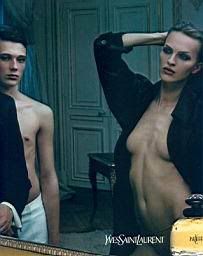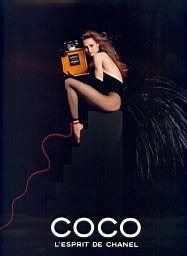
The issue of what differentiates female from male idiosyncrasies in general is complicated enough. In perfume terms the composition of different formulas for the two sexes (roughly floral and oriental for the ladies, woody and citrus for the gentlemen) is a fairly recent phenomenon, dating from the dawn of modern perfumery in the end of the 19th century. Up till then, there was pretty much lots of leeway for men to delve in floral waters of the Victorian era or even the rich civet and musk laden compositions of the 18th century decadence. The issue of how male and female attributes translate in the iconography of perfume though is worth investigating for its many surprising facets.
Here today I decided to delve in some perfume commercials that redefine the role of gender as we know it.
The 70s were the years when it was acceptable for the first time after many long years for a woman to appear in pants. Up till then, emulating a man’s wardrobe was considered outré and not to be encouraged. In upscale restaurants and hotels in the 60s, time of the mini, it was customary to ask ladies in pantsuits to remove the pants and just wear the long jackets as dresses. Katherine Hepburn in her signature slacks was repeatedly asked to use the staff hotel stairways when going to see Spencer Tracy some years prior. In that regard, the first ad for perfume that showcased this new freedom was Charlie by Revlon. Codenamed “Cosmo” while being developed, as this was intended for the young and liberated Cosmopolitan readers, that magazine being full of women’s liberation articles back then besides the tips for better sex; it then got named Charlie from the first name of Charles Revson, owner of Revlon. The face of Charlie was Shelley Hack whom you may remember as part of “Charlie’s Angels” TV series, here with Bobby Short. Watch the clip clicking here
Indeed watching the commercial, Shelley dressed in a shiny satiny ensemble of pants and shirt, with a matching little hat on her short bouncy do, it takes a close up to see that it’s actually a female. The fact that she is thin and with no discernible décolletage makes it even more risqué. As she sprays the perfume on her neck while in the car before getting out at her destination we get a glimpse of what an emancipated woman is like; driving, wearing the pants, getting alone to the place she is invited. There is no need for a man to accompany her. She is the man in her life. So recent commercials compared to that seem to tie women to their traditional roles of either homemaking material (pretty, happy) or dangerous fantasy (aggressive seductresses). But that is as much a societal phenomenon as to warrant a separate article of its own on another venue.
Many years later it was advertising provocateur Calvin Klein who brought homosexuality in the mainstream with his memorable commercials. As an aside when talking about the issue, please note that it is males of such a preference who feature prominently in the ads, not women. This may have to do with more homosexual men being involved in the media in the first place (and we all know the designing world is full of them), but it also has to do with the taboo of female homosexuality in advertising as well. For some reason, women in advertisers’ minds should be seen as dynamic, but not butch, aggressive as they are often depicted in the sexual arena, but not manly. I guess it has to do with the male mindframe being deeply disturbed by the idea that a woman renounces the attributes that make him the center of her universe, even though he may renounce those that make him desirable to her! Egotistical though it may sound, men seem flattered if women are concentrating on them. Homoerotic female images are desirable – and intensely so- only if they entail a man eventually and only if the ladies in question outwardly look very stereotypically feminine. To revert to Calvin Klein though, his commercials exploit the homoerotic ideal to the max. A series of commercials for Obsession as well as Eternity used photographer Herb Ritts as the vehicle for an aesthetic that was distinct in an American way.
To witness, these 4 short clips for Eternity for men from the 80s, featuring the exotic Shana Zadhrick as the female presence in an otherwise male territory, which idolize the male physique, sculpted during long hours at the -then- temple: the gym. The droplets of water on rippled flesh, the eroticism of swimmers’ bathing suits, the movement that is resembling diving. Everything speaks of the promise of a different erotic experience.
Watch the clip clicking here
And then of course we have the cheeky ironic representation of Le Male by Jean Paul Gaultier. The theme is reprised in a tongue-in-cheek way (as Gaultier takes himself far less seriously than Klein) and the sailor and his uniform, both a nod to a popular homosexual icon and Jean Paul’s favourite matelot top as well, make their appearance in ads that emanate a playful mockery. Le Male the jus is full of the traditional male note of lavender and yet it is so sweet that it has a candy like tone, like only someone who is totally oblivious to rules of propriety is capable of carrying off. In the following commercial Gaultier not only depicts the sexual deviant of a sailor, but dresses a woman in the sailor uniform -shot from behind, walking in what seems a bar full of such sailors- in a transvestite effort in reverse, having her kiss another male, only to reveal that underneath her clothes she is corseted in the traditional attire of her sex from long ago, to match the torso of his eponymous feminine scent, known as Classique. It is important to note that the ad refers to men and the eternal female. Even openly homosexual men have their prejudices about women I guess, or perhaps they have had strong female icons in their environment shaping their views on the subject, as in Gaultier’s case with his grandma. Watch the clip clicking here
In another Jean Paul Gaultier commercial, this time for Classique only, several models sit on a table talking about l’amour (love), differentiating in attire and image as day and night, one of them being the androgynous Eve Salvail, a Canadian model with a tattoo on her shaven head. The old woman suddenly and briefly morphs into Gaultier himself, as if the designer wants to remind us that some part of his grandmother's spirit which inspired the perfume still lives in him. Whatever, Classique is a very feminine scent. Watch the clip clicking here

While at it, you can witness the difference in perception of what is appropriate and what is not in the iconography of these two similar print ads for Paris by YSL, under artistic direction of Tom Ford. The top one is the US version, nipples covered and the effeminate face of the guy cut from the photo, only the cuff hinting at a ménage a trois. In the European version, shown here, however, such niceties do not cut it and the whole deal is laid bare –pun intended- for readers. Pity Paris perfume which used to be viewed as elegant, it now has earned a reputation for racy.
Last but not least, Calvin Klein again plays the gender bender with his masterful commercial "Altered States" (which reminds me of a William Hurt starring film) for both CKone and CKbe. The diaphanous and black bottles respectively are used in brilliant effect for a morphing computer play that emits a weird and truly wonderful vibe that compels the viewer to watch the clip over and over again. I find it seriously cool in its androgyny despite the eerie factor. The limits between the sexes have never been thinner and the interplay between the two is evinced in the unisex jus of the two perfumes which represent two different moods, but never two different sexes. Watch the clip clicking here The 90s heralded the cult of the unisex, or euphemistically called shared perfumes and the commercials that played upon this were many and varied. In my opinion this is the most memorable and worth watching one. What the future brings is anyone's guess.
Next post will revert to softer, more romantic notions and the discrepancy between image and smell.
Pics from imagesdesparfums.
.jpg)

.jpg)




